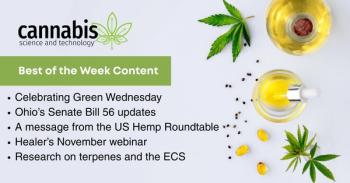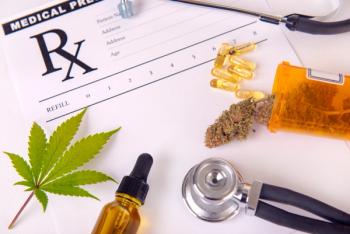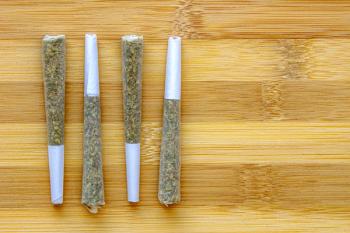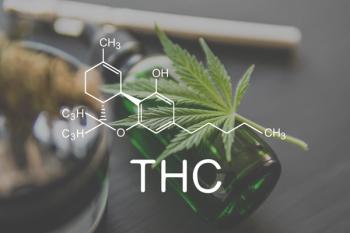
Cannabis Science and Technology
- July/August 2025
- Pages: 6-11
A New Method for Determining Potency in Wet Cannabis

Key Takeaways
- Raman spectroscopy enables in-field potency analysis of wet cannabis, bypassing the drying process.
- The method accurately classifies hemp samples with 93% success in determining legal THC levels.
Using Raman spectroscopy to measure potency in wet hemp and cannabis plant material would allow cultivators to analyze plants in the field without having to dry them. In experiments testing this methodology, Raman scans were able to correctly classify 93% of hemp samples as being above or below 0.35% total THC, and in cannabis, analysis of total THC had a relative error rate of 6%, which is below the 10% error rate allowed by many jurisdictions.
Using Raman spectroscopy to measure potency in wet hemp and marijuana plant material would allow cultivators to analyze plants in the field without having to dry them. In experiments testing this methodology, Raman scans were able to correctly classify 93% of hemp samples as being above or below 0.35% total THC, and in marijuana, analysis of total THC had a relative error rate of 6%, which is below the 10% error rate allowed by many jurisdictions.
It is my habit to write a column series dedicated to specific instrumental techniques that are relevant to cannabis analysis. For example, there was a series dedicated to infrared spectroscopy’s use in potency analysis (1-7) and also a series dedicated to chromatography which is used for potency, terpene, and pesticide analysis (8-15). As of the last issue I was in the middle of a series of columns on mass spectrometry, which is also used for potency and pesticide analysis (16,17). However, I need to interrupt our regularly scheduled column series for a new development in potency analysis that I think will interest you. This new method utilizes Raman spectroscopy (more on this later) to accurately predict potency in wet hemp and marijuana plant material. This means cannabis plants can be analyzed in the field without having to dry them. This method is based on the pioneering work of Prof. Dmitry Kurouski at Texas A&M University and the scientific team at Mariposa Technology (18-22). In the interest of full disclosure, I acted as a paid consultant for Mariposa Technology in some of this work. Regardless, I think these results are of great enough interest to the cannabis industry to merit discussion here.
Introduction to Raman Scattering and Spectroscopy
Raman spectroscopy is based on the physical phenomenon of Raman scattering (23). A diagram of the Raman scattering process is seen in Figure 1.
The purple dot in the upper left of Figure 1 represents a photon, which is a particle of light with energy Ep but no mass. A methane molecule, CH4, at rest is represented by a sphere (a circle in two dimensions) at the lower left. Now, I realize that the true chemical structure of methane is a tetrahedron, but for our purposes, it is easiest to think of the methane molecule as a sphere.
Once the photon collides with the methane molecule it can vibrationally excite the molecule causing the chemical bonds to stretch and bend. This is illustrated in Figure 1 where our spherical methane molecule is vibrating by getting bigger and smaller. Imagine the photon is a hammer, the molecule is a bell, and when the two collide the bell/molecule ends up “ringing.”
After the collision, the methane molecule now has energy Ev, which stands for vibrational energy, and the departing molecule now has less energy than before denoted Ei. Note that the photon has changed energy and direction as a result of its collision with the methane molecule. Note also that the departing photon is now green, which is lower in energy than violet light, indicating the amount of energy lost to the molecule as a result of the collision. The process via which the photon loses some of its energy to the molecule via a collision is called inelastic scattering.
As with all physical processes, the law of conservation of energy must be observed here. Thus, the photon energy before the collision must equal the amount of vibrational energy left behind in the methane molecule plus the energy of the departing photon as given by Equation 1, where Ep is the energy of photon, Ev is vibrational energy deposited in molecule, and Ei is the energy in departing photon after the collision.
It is well known that the vibrational energy levels of a molecule are determined by chemical structure. We make use of this relationship in infrared spectroscopy to determine the molecular structure of unknown molecules (24). We can analyze Raman scattered photons (the green one in Figure 1) using a spectrometer to determine their energy. We can then calculate the Ev of the molecule by rearranging Equation 1 to obtain Equation 2 (all symbols have the same meaning as for Equation 1).
As a result of inelastic collisions, the incoming photons can lose different amounts of energy corresponding to the different vibrational energy levels of the molecule. By analyzing the energies of the Raman scattered photons we can obtain a spectrum of the molecule. Figure 2 shows the Raman spectrum of sucrose (table sugar).
The peak positions in a Raman spectrum each represent a specific vibrational energy level of a molecule. Thus, a Raman spectrum provides information similar to infrared spectroscopy, and since vibrational energy levels are determined by molecular structure, both Raman and infrared spectroscopies can be used to determine molecular structure.
The experimental setup originally used by the discoverer of Raman scattering, C. V. Raman, is shown in Figure 3.
Dr. Raman used sunlight as his source and a filter that only allowed violet light to pass. The choice of violet is no accident, this is the highest energy light the human eye can see and as it turns out the intensity of Raman scattering is proportional to photon energy, so violet light will be the most strongly scattered of all types of visible light (23). The violet light was allowed to impinge on a vial of organic liquid. He placed a filter perpendicular to the path of the incoming light beam that only allowed green light to pass. He then simply looked at what was coming through this filter. He observed green light, proving the existence of inelastically scattered photons, what we now call the Raman effect and Raman scattering. Using this elegant experimental apparatus, Dr. Raman won the Nobel Prize in Physics in 1930.
In the summer of 2012, I had the privilege of attending the International Conference on Raman Spectroscopy (ICORS) which was held in Bangalore, India, at the Indian Institute of Technology. On display in the lobby of the chemistry building is the actual experimental apparatus used by C. V. Raman to discover the Raman effect, whose schematic diagram is seen in Figure 3. It was a special honor to be in the presence of such a historically important scientific apparatus. Today we use lasers instead of the sun as a light source, grating spectrometers to separate the scattered light into its various colors, and electronic detectors instead of eyeballs to measure a sample’s spectrum (23). You have not heard of a Raman spectroscopy-based dried cannabis plant material potency analyzer because the laser used in the analysis can set the sample on fire! Hence, the need for the sample to be wet.
For the purposes of cannabis potency analysis, we seek to measure the concentration of Total THC (TTHC) in a sample. In earlier columns (1-7) I discussed how an equation called Beer’s Law is used in infrared spectroscopy to determine concentrations of molecules in samples. In essence, Beer’s Law states that the height or area of a peak in an infrared spectrum equals the product of molecule concentration, sample thickness, and a proportionality constant called the absorptivity. There is a similar relationship in Raman spectra, where the peak height or area in a spectrum is proportional to the product of molecule concentration, the thickness of sample seen by the impinging light beam, and a proportionality constant called the cross section (23). This means Raman spectroscopy is quantitative and can be used to measure concentrations in samples.
Raman Analysis of Hemp
The work I am about to present here is new but is based on previous studies (18-22). The handheld Raman spectrometer used in this work is the Resolve spectrometer made by Agilent. 50 plants from two different farms were selected for examination. Initially scans of both buds and sugar leaves were made, but we found the leaf data gave better results, probably because their surface is flatter and allowed collection of more Raman scattered photons.
In all experiments, a fresh, wet sugar leaf was used. Sugar leaves are those that grow next to a bud. Only leaves that looked green and healthy were used. Raman scans of three separate spots on a given sugar leaf were made and results were averaged. A Raman spectrum of a hemp plant sugar leaf is seen in Figure 4.
The bud to which a given sugar leaf was attached was harvested, dried, and submitted to an ISO-certified, state licensed lab for potency determination by high pressure liquid chromatography (HPLC) (8-15). The standard samples had TTHC values ranging from 0.01% to 0.58%. What we sought to do was to correlate the Raman scans of a wet sugar leaf of a given plant to the Total THC of a dried bud from the same plant. The PLS-1 algorithm (25) was chosen to establish this correlation. Input into the model were a calibration set of 146 scans of the leaves of the plants selected and the corresponding HPLC data. The spectral region from 1700 to 1600 cm-1 was chosen and three principal components were used. The spectra were used as is with no pre-processing.
The United States Department of Agriculture (USDA) has issued regulations stating that cannabis plant material with Total THC values of 0.3% by dry weight or less is legal (26). To take experimental error into account, USDA has also stated that the margin of error should be added to the 0.3% number to establish an upper limit of what is legal. For this study we used a value of 0.35% by weight Total THC as this upper limit.
For a hemp farmer their biggest concern is not so much what the Total THC level is, but whether their crop is above or below the legal limit. We thus felt that an instrument that gave a green indicator if the sample was 0.35% Total THC or less, or a red indicator if it was above 0.35% would be of greatest use to the industry. So, for a given sample the Total THC value is determined using the PLS-1 algorithm discussed above, the value compared to the 0.35% Total THC limit, and then the appropriate indicator is displayed. The quality metric for this method then is the percent of samples correctly identified as being above or below 0.35% Total THC.
The method was validated by selecting 15 scans at random and removing them from the calibration set. A new calibration with these spectra removed was obtained, then this calibration was applied to the 15 scans in the validation set. Using the above or below 0.35% Total THC criterion discussed above, 93% (14 out of 15) of the validation samples were correctly identified as being above or below the established limit. These results establish that there is a correlation between the Raman scans of wet hemp sugar leaves and TTHC content in the attached buds. It is not likely that we are detecting the tetrahydrocannabinol (THC) directly since it is present in low concentrations. We are detecting the concentration of some other component, such as the carotenoids, that scales with THC concentration. This new method gives the cannabis industry a fast, accurate, and portable means of determining hemp legality.
Raman Analysis of Marijuana
Given the success of our work on hemp with less than 1% TTHC, we tried determining the potency of marijuana buds since the analyte concentration often ranges from 10% to upwards of 30%. Eighteen marijuana plants from a single farm were chosen for study. As above, three scans of a wet sugar leaf from each plant were made for a total of 54 Raman spectra, and a bud from the same plant was collected, dried, and its TTHC value determined by HPLC. In this case, the chromatograph used was an Orange Photonics unit (27), which is commonly used in the cannabis industry. TTHC values for these standard samples ranged from 10.4% to 20.1%. A calibration model using as input the Raman spectra and HPLC data was made using the PLS-1 algorithm using the 1700 to 1300 cm-1 spectral range and four principal components. No spectral pre-processing was used. The resultant calibration line is seen in Figure 5.
In the plot, the x-axis is TTHC in dried marijuana buds as determined by HPLC (“actual”), and the y-axis is the TTHC predicted from Raman scans of wet cannabis leaves. To plot this data, three scans were made of each leaf, three TTHC determinations were made, and then these were averaged to give the data for an individual plant. The Average Standard Error of Calibration, the standard deviation (28) between the actual and average predicted TTHC values for the calibration samples, and a measure of model accuracy, was 1.26 Wt. %. The correlation coefficient, R, a measure of model quality (29), is 0.94, where a value of 1 is a perfect model. Given that many marijuana buds have potencies of about 20%, this represents a relative error of 6%. Some jurisdictions, including the State of California, are satisfied with a potency method capable of 10% relative error or less, which we have achieved. These are excellent results given the challenges of predicting the TTHC in a dried marijuana bud from the scan of a wet leaf from the same plant.
Conclusions
Raman scans of wet, fresh off the plant hemp and marijuana sugar leaves were made and subsequently buds from the same plants were dried and analyzed for weight percent TTHC by HPLC. Calibration models were built using the PLS-1 algorithm. For hemp analysis, the figure of merit was the percent of validation samples correctly classified as being above or below 0.35% TTHC. Our model correctly classified 14 out of 15 validation samples for an accuracy of 93%. For marijuana, the same process of scanning wet leaves was followed and dried buds from the same plants were submitted for HPLC analysis. The accuracy for the analysis of TTHC in marijuana buds is 1.26 Wt.% with a relative error of about 6%, much less than the 10% required by many jurisdictions.
The totality of this work shows that Raman scans of wet cannabis sugar leaves can accurately predict TTHC values in dried buds of the same cannabis plants across a TTHC range of 0.01% to 20.1%. This technique can be used by cannabis cultivators in the field to determine the potency of their grows immediately and on the spot, negating the need to dry buds and send them out for slow and expensive lab analysis. This will allow growers to optimize growing conditions and harvest times to maximize product quality and profit.
References
- Smith, B.C., The Most Important Equation in Potency Analysis is Beer’s Law: An Introduction, Cannabis Science and Technology. 2022, 5(2), 10-13.
- Smith, B.C., Beer’s Law, Part II: Physical Basis and Derivation, Cannabis Science and Technology. 2022, 5(3), 10-14.
- Smith, B.C., Beer’s Law, Part III: Demystifying the Absorptivity, Cannabis Science and Technology. 2022, 5(4), 8-15.
- Smith, B.C., Quantitative Spectroscopy: Practicalities and Pitfalls, Part I, Cannabis Science and Technology. 2022 5(5) 8-13.
- Smith, B.C., Quantitative Spectroscopy: Practicalities and Pitfalls, Part II, Cannabis Science and Technology. 2022, 5(6), 8-11.
- Smith, B.C., Quantitative Spectroscopy Pitfalls and Practicalities, Part III: Calibration Validation and Calibration Checks, Cannabis Science and Technology. 2022, 5(7), 8-11.
- Smith, B.C., Quantitative Spectroscopy Pitfalls and Practicalities, Part IV: The Finale, Cannabis Science and Technology. 2022, 5(8), 10-13.
- Smith, B.C., Principles of Chromatography, Part I: Theory, Cannabis Science and Technology. 2022, 5(9), 8-11.
- Smith, B.C.,
Chromatography Theory, Part II: How Separations Occur Illustrated and Quantitated , Cannabis Science and Technology. 2023, 6(1), 7-12. - Smith, B.C., Chromatography Theory, Part III: Calculating Elution Times and Capacity Factors, Cannabis Science and Technology. 2023, 6(2), 8-11.
- Smith, B.C., Chromatographic Theory, Part IV: Measuring Separation Quality with Capacity and Separation Factors, Cannabis Science and Technology. 2023, 6(3), 10-13.
- Smith, B.C., Chromatographic Theory, Part V: Chromatographic Resolution, Cannabis Science and Technology. 2023, 6(4), 8-11.
- Smith, B.C., Chromatographic Theory, Part VI: Peak Widths, Band Spreading, and Plate Number, Cannabis Science and Technology. 2023, 6(5), 6-9.
- Smith, B.C., Chromatographic Theory, Part VII: The Master Chromatographic Resolution Equation, Cannabis Science and Technology. 2023, 6(6), 7-11.
- Smith, B.C., The Ongoing Myth of Potency Accuracy in Cannabis Analysis, Cannabis Science and Technology. 2023, 6(8), 6-12.
- Smith, B.C., Mass Spectroscopy Primer, Part I: Introduction. Cannabis Science and Technology, 2025, 8(1), 6-9.
- Smith, B.C., Mass Spectroscopy Primer, Part II: Data Interpretation. Cannabis Science and Technology. 2025, 8(2), 6-9.
- Sanchez, L.; Filter C.;, Baltensperger, D.; and Kurouski, D. Confirmatory non-invasive and non-destructive differentiation between hemp and cannabis using a hand-held Raman spectrometer Royal Society of Chemistry Advances, 2020, 10, 3212-3216. DOI: 10.1039/C9RA08225E
- Goff, N.; Guenther, J.; Roberts III, J.; Adler, M; Dalle Molle, G; Mathews, G.; and Kurouski, D. Non-Invasive and Confirmatory Differentiation of Hermaphrodite from Both Male and Female Cannabis Plants Using a Hand-Held Raman Spectrometer. Molecules2022, 27,4978. DOI: 10.3390/molecules27154978
- Sanchez, L.; Baltensperger, D.;and Kurouski, D.Raman-Based Differentiation of Hemp, Cannabidiol-Rich Hemp, and Cannabis. Analytical Chemistry, 2020, 92 (11), 7733–7737. DOI: 10.1021/acs.analchem.0c00828
- Higgins, S.; Jessup, R.; and Kurouski, D. Raman spectroscopy enables highly accurate differentiation between young male and female hemp plants. Planta. 2022, 255, 85. doi: 10.1007/s00425-022-03865-8
- Mariposa Technology, Inc.
https://mariposatechnology.com/ - McCreery, R. Raman Spectroscopy for Chemical Analysis, Wiley, New York, 2000.
- Smith, B.C. Infrared Spectral Interpretation: A Systematic Approach, CRC Press, 1999.
- Smith, B.C. Quantitative Spectroscopy: Theory and Practice, Elsevier, New York, 2002.
- Federal Register. Establishment of a Domestic Hemp Production Program
https://www.federalregister.gov/documents/2021/01/19/2021-00967/establishment-of-a-domestic-hemp-production-program - Orange Photonics Analytical Instrumentation, Light Lab 3
https://orangephotonics.com/ - Smith, B.C., Statistics for Cannabis Analysis, Part I: Standard Deviation and Its Relationship to Accuracy and Precision, Cannabis Science and Technology, 2021, 4(8), 8-13.
- Smith, B.C., Calibration Science, Part III: Calibration Lines and Correlation Coefficients, Cannabis Science and Technology, 2024, 7(11), 6-11.
About the Columnist
Brian C. Smith, PhD, is Founder, CEO, and Chief Technical Officer of Big Sur Scientific. He is the inventor of the BSS series of patented mid-infrared based cannabis analyzers. Dr. Smith has done pioneering research and published numerous peer-reviewed papers on the application of mid-infrared spectroscopy to cannabis analysis, and sits on the editorial board of Cannabis Science and Technology. He has worked as a laboratory director for a cannabis extractor, as an analytical chemist for Waters Associates and PerkinElmer, and as an analytical instrument salesperson. He has more than 30 years of experience in chemical analysis and has written three books on the subject. Dr. Smith earned his PhD on physical chemistry from Dartmouth College. Direct correspondence to:
How to Cite this Article
Smith, B., A New Method for Determining Potency in Wet Cannabis, Cannabis Science and Technology, 2025, 8(4), 6-11.
Articles in this issue
Newsletter
Unlock the latest breakthroughs in cannabis science—subscribe now to get expert insights, research, and industry updates delivered to your inbox.





